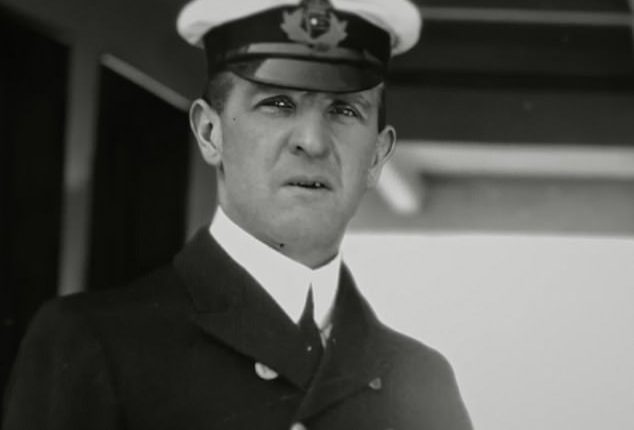It has been 113 years since the Titanic sank beneath the waves, claiming the lives of more than 1,500 passengers and crew.
But new evidence has finally cleared the tragedy’s Scottish scapegoat: First Officer William Murdoch.
For years, Officer Murdoch has been accused of taking bribes, abandoning his post, and was even depicted shooting a passenger in the James Cameron movie.
Now, more than a century later, 3D scans show that Officer Murdoch did not flee his position, but died while helping passengers escape until the very end.
Deep sea scanning company Magellan has snapped 715,000 photos of the Titanic wreck 12,500 feet beneath the Atlantic.
In a new National Geographic documentary, Titanic analyst Parks Stephenson reveals how this enormous digital model supports Officer Murdoch’s innocence.
Scans show that the davit – a type of crane used on ships – at Officer Murdoch’s station was getting ready to launch another lifeboat when the Titanic went under.
This supports testimony from surviving crew members that Murdoch, age 39 at the time of his death, was swept away by a wave as he launched one more group of passengers to safety.

113 years after the Titanic sank beneath the waves, 3D scans have finally cleared the name of the tragedy’s Scottish scapegoat First Officer William Murdoch (pictured)

Deep sea scanning company Magellan has snapped 715,000 photos of the Titanic wreck 12,500 feet beneath the Atlantic, creating a precise model of the ship which reveals new clues about the crews’ final moments

Scans show that a davit, a crane used on ships, operated by Officer Murdoch was in the upright position as the Titanic sank. This means that Officer Murdoch did not abandon his post as if often claimed, but died helping people escape
William McMaster Murdoch was born on 28 February 1873 in the town of Dalbeattie, Scotland, and served on a number of vessels before eventually being promoted to the position of First Office aboard the Titanic.
In September 1907 he married a school teacher from New Zealand named Ada Florence Banks – but the last time he would see his wife was on 10 April 1912, before the Titanic departed from Southampton.
When the Titanic struck the iceberg at 11.40pm on the evening of April 14, 1912, Officer Murdoch was placed in charge of evacuations on the starboard side of the ship.
However, what transpired during the hours that followed has been a matter of controversy.
Several surviving eyewitnesses reported seeing an officer shoot one or two men who were rushing for a lifeboat and then shoot himself.
For years, this unnamed officer was believed to have been Officer Murdoch – an idea repeated in the James Cameron film adaptation.
However, other critical pieces of witness testimony disagreed with this negative interpretation.
In particular, Second Officer Charles Lightoller claimed he saw Officer Murdoch from the top of the deckhouse as he was swept away by the sea.

In the James Cameron film adaption, Officer Murdoch is played by Ewan Stewart and is shown shooting a passenger and then himself during a chaotic rush for the lifeboats

RMS Titanic – owned and operated by British company White Star Line – tragically sank in the early hours of April 15, 1912, after a collision with an iceberg in the Atlantic Ocean, killing an estimated 1,517 of the 2,224 people on board
According to Lightoller’s account, Officer Murdoch had been preparing one final lifeboat when the ship pitched suddenly, sending a wave washing over the deck.
While some passengers were able to scramble into the lifeboat, Officer Murdoch was washed away, and his body was never recovered.
Finally, the most precise 3D scan of the Titanic ever produced has revealed evidence that supports Lightoller’s testimony.
Mr Stephenson says: ‘This davit is in the up position, meaning its crew is basically trying to get a lifeboat ready to be launched.’
He adds: ‘This coincides with Second Officer Lightoller’s description.’
This suggests that Officer Murdoch never abandoned his position and kept attempting to launch lifeboats until the very end.
‘This davit right here stands in mute testimony that supports Lightoller’s version of events because being in the up position is exactly what Lightoller described.’
Despite his bad reputation and accusations of improper conduct, Officer Murdoch is now generally regarded as having acted to save the lives of hundreds.
Unlike some of the other officers aboard, Officer Murdoch ignored the order to send women and children first and allowed men to board the boats as well.
After the release of the Titanic movie, Murdoch’s surviving relatives and residents of his native Dalbeattie, Scotland complained that the film had damaged his heroic reputation.

According to the account of Second Officer Charles Lightoller (back row, second from left), Officer Murdoch (front row, far right) was killed while loading a final lifeboat after a sudden wave swept him away. This picture shows Captain Edward Smith (front row, second from right) and the other officers of the Titanic

New 3D scans of the Titanic have created the most precise model of the ship ever created, revealing exactly how it looks on the sea floor
Eventually, Fox Vice-President Scott Neeson went to Dalbeattie to personally deliver an apology to the Murdoch family and donated £5,000 to Dalbeattie High School to fund the William Murdoch Memorial Prize.
RMS Titanic – owned and operated by British company White Star Line – tragically sank in the early hours of April 15, 1912, after a collision with an iceberg in the Atlantic Ocean, killing an estimated 1,517 of the 2,224 people on board.
Its remains now lie on the seafloor about 350 nautical miles off the coast of Newfoundland, Canada.
The delicate wreck is deteriorating so rapidly underwater that it could disappear within the next 40 years but is now preserved exactly as it was in 2022 by the digital scan.
The scans have been studied for a new documentary by National Geographic and Atlantic Productions called ‘Titanic: The Digital Resurrection’.
It follows the first batch of digital scan images from Magellan Ltd released two years ago that revealed the 3D reconstruction of the wreck.
As well as the imagery, a new simulation reconstructs the RMS Titanic, and the damage caused on that tragic night nearly 113 years ago exactly.
Titanic broke in half just before it made its final plunge in the early hours of April 15, 1912, and now two parts of the ship – the bow and the stern – lie 2,600 feet apart.

These scans show that the Titanic did not cleanly break apart but was ‘violently torn’ into two pieces, scattering debris over the seabed

The incredible detail of the scan shows that windows 30ft above the waterline were broken, supporting witnesses’ accounts that ice burst into peoples’ cabins

The scans also revealed an open valve (pictured) which would allow steam to flow into the ship’s generator. This backs up eyewitness reports from the fateful night that a team of brave engineers worked right to the end to keep the ship’s lights on
Analysis of fragments lying on the ocean floor shows that the ship didn’t break apart cleanly but was ‘violently torn apart’.
Also revealed by the scans is a valve in an open position, indicating that steam was still flowing into the Titanic’s electricity generating system.
This backs up eyewitness reports from the fateful night that a team of brave engineers worked right to the end to keep the ship’s lights on.
The team, led by Cumbria-born engineer Joseph Bell, worked to shovel coal into the furnaces to keep the lights on.
All died in the disaster, but their heroic actions saved many lives by giving crew time to launch the lifeboats safely.
The full footage can be seen in Titanic: The Digital Resurrection on Tuesday 15th April at 8 pm on the National Geographic Channel.









